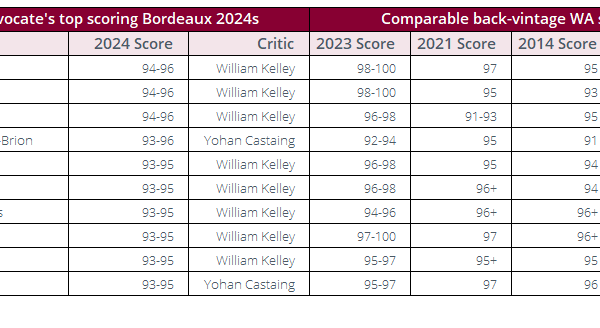Today's blog is by the Bordeaux wine producer and writer Gavin Quinney (@GavinQuinney), who has kindly provided us with his notes and scores for Bordeaux 2012. He has tasted over 500 wines from the vintage.
Key points about Bordeaux 2012:
- 2012 is a good to very good vintage, but not a great
one. - It’s certainly a vintage for drinking, not investment.
Many wines will be good to drink in the short to medium term. - 2012 was a late harvest which tended to favour the
earlier ripening Merlot over the Cabernets, partly because drizzle,
humidity and finally heavy rain set in from the second week of October
onwards. - It’s an uneven vintage but hundreds of reds have lovely
colour, supple fruit, crowd-pleasing texture and no hard edges. - Happily, very few wines show any green, unripe character.
The fruit is ripe (thanks to ten weeks of sunshine from mid-July onwards)
even if many wines lack real depth, complexity and length. - 2012 is notably strong in the 'précoce' terroirs of the
Right Bank, and south of Bordeaux in the northern Graves. More often than
not, for Merlot. - The plateau of Pomerol is successful, but it’s tiny and
expensive. Several candidates for ’wine of the vintage’ come from here. - Merlot on the clay and limestone terroirs around the
town of St-Emilion (and beyond) also fared well. Here there are some great
wines, although you have to pick those that suit your palate, and
pocket. - There are many attractive Crus Classés in the Medoc,
yet few big scoring wines for me (or for Mr Parker, I’d suggest). It might
have been different if October had been kinder to the Cabernets. - There are some real successes, and possible values,
from all four of the major Medoc appellations (Margaux, St-Julien,
Pauillac and St-Estephe) but there are several fairly disappointing wines,
including some big names. I think you have to treat them on a chateau by
chateau basis. - It’s not quite correct to say that it’s a Right Bank
vintage, however. There are some lovely wines from Pessac-Leognan on the
left bank, south of Bordeaux, and many estates there produced fine dry
whites to boot. The Graves should prove to be a source of values in 2012. - There are many pretty wines from the petit chateaux of
the Right Bank, less so for the Cru Bourgeois of the Left. It’s a vintage
to re-evaluate after bottling at this level. - Élevage – barrel ageing – will be key. With such gentle
fruit, new oak could dominate while older oak barrels can dry out a wine.
It's not that the wines are over-oaked; they could simply be under-wined. - Thankfully, few estates got it wrong with the dreaded
’over-extraction’. - Hundreds of estates have seriously upped their game in
the last decade or so. There’s much more precision than there used to be –
in the vineyard, with picking dates, in sorting the grapes, in the
wine-making – and there’s stricter selection for the final blends. It
shows in the wines, almost more so in 2012 than in a uniformly good year
like 2010. - It’s a fine vintage for dry whites, and not just at the
top level in Pessac-Léognan. Most Sauvignon and Sémillon across Bordeaux
were picked in fine weather in mid-September, in very good
condition. - The summer drought and October rains proved difficult
for sweet wines after three excellent years on the trot. Although some big
names declared that they wouldn't be making a wine this year (Yquem,
Rieussec and so on) there are, in fact, some heroic efforts from Sauternes
and Barsac. In small quantities.
Comparison with another vintage? None, as far as the climate goes. 1998
perhaps, 2001 even? Not really. As it was a case of 'picking before the rains' for many chateaux, 2012 could even be a modern take on 1964 (great Pomerols,
St-Emilions and Graves, awkward in the Medoc on the whole). But much has
changed since the Beatles.
Actually, never mind 1964, a lot has changed since 2004. Not least, the prices.
Onwards and upwards.
Gavin's top 40 Bordeaux 2012s:




